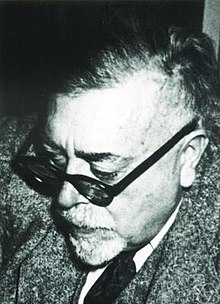Classical Wiener space
In mathematics, classical Wiener space is the collection of all continuous functions on a given domain (usually a sub-interval of the real line), taking values in a metric space (usually n-dimensional Euclidean space). Classical Wiener space is useful in the study of stochastic processes whose sample paths are continuous functions. It is named after the American mathematician Norbert Wiener.

Definition
Given and a metric space , the classical Wiener space is the vector space of all continuous functions : i.e., for every (fixed) ,
- as
In almost all applications, one takes or and for some . For brevity, write for . Write for the linear subspace consisting only of those paths that start at the origin. (Many authors refer to as "classical Wiener space".)
The more general case is treated in, for example, Billingsley.
Properties of classical Wiener space
Uniform topology
The vector space can be equipped with the uniform norm
turning it into a normed vector space (and indeed into a Banach space as we will see below.) This norm induces a metric on in the usual way: . The topology generated by the open sets in this metric is the topology of uniform convergence on , or the uniform topology.
Thinking of the domain as "time" and the range as "space", an intuitive view of the uniform topology is that two functions are "close" if we can "wiggle space a bit" and get the graph of to lie on top of the graph of , while leaving time fixed. Contrast this with the Skorokhod topology, which allows us to "wiggle" both space and time.
Separability and completeness
With respect to the uniform metric, is both a separable and a complete space:
- separability is a consequence of the Stone-Weierstrass theorem;
- completeness is a consequence of the fact that the uniform limit of a sequence of continuous functions is itself continuous.
Since it is both separable and complete, is a Polish space.
Tightness in classical Wiener space
Recall that the modulus of continuity for a function is defined by
This definition makes sense even if is not continuous, and it can be shown that a function is continuous if and only if its modulus of continuity tends to zero as :
- as
By an application of the Arzelà-Ascoli theorem, one can show that a sequence of probability measures on classical Wiener space is tight if and only if both the following conditions are met:
- and
- for all
Classical Wiener measure
There is a "standard" measure on , known as classical Wiener measure (or simply Wiener measure). Wiener measure has (at least!) two equivalent characterizations:
If one defines Brownian motion to be a Markov stochastic process , starting at the origin, with almost surely continuous paths and increments
then classical Wiener measure is the law of the process .
Alternatively, one may use the abstract Wiener space construction, in which classical Wiener measure is the radonification of the canonical Gaussian cylinder set measure on the Cameron-Martin Hilbert space corresponding to .
Classical Wiener measure is a Gaussian measure: in particular, it is a strictly positive probability measure.
Given classical Wiener measure on , the product measure is a probability measure on , where denotes the standard Gaussian measure on .
See also
- Skorokhod space, a generalization of classical Wiener space, which allows functions to be discontinuous.
- Abstract Wiener space
- Wiener process.
References
- Billingsley, Patrick (1995). Probability and Measure. John Wiley & Sons, Inc., New York. ISBN 0-471-00710-2.








![{\displaystyle E=[0,T]\,}](https://wikimedia.org/api/rest_v1/media/math/render/svg/ef3e439c75fc0988d42970ed0fc6ac5371d83f8e)




![{\displaystyle C([0,T];\mathbb {R} ^{n})}](https://wikimedia.org/api/rest_v1/media/math/render/svg/9bd01a6e636c11686e7dcd8239a517534f752e99)

![{\displaystyle \|f\|:=\sup _{t\in [0,T]}|f(t)|}](https://wikimedia.org/api/rest_v1/media/math/render/svg/9bae264f35e1df25d09204d22430f41afa3f04fe)

![{\displaystyle [0,T]}](https://wikimedia.org/api/rest_v1/media/math/render/svg/35ccef2d3dc751e081375d51c111709d8a1d7ac6)



![{\displaystyle f:[0,T]\to \mathbb {R} ^{n}}](https://wikimedia.org/api/rest_v1/media/math/render/svg/cc92240c77f905bda70b876d72675c98b6792f78)
![{\displaystyle \varpi _{f}(\delta ):=\sup \left\{|f(s)-f(t)|\left|s,t\in [0,T],|s-t|\leq \delta \right.\right\}.}](https://wikimedia.org/api/rest_v1/media/math/render/svg/64d563116343a79e15480ec996c569de475d2959)







![{\displaystyle B:[0,T]\times \Omega \to \mathbb {R} ^{n}}](https://wikimedia.org/api/rest_v1/media/math/render/svg/6cdcc269bb7a98cfcc6b555c33056a7a39ac1b01)




